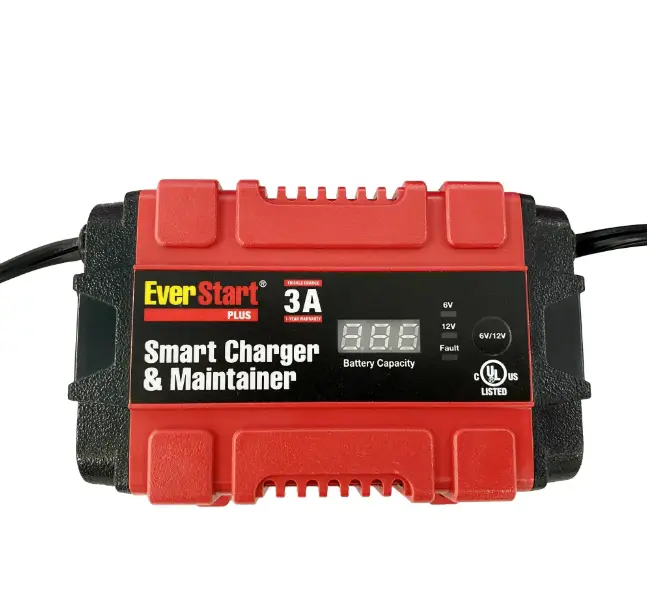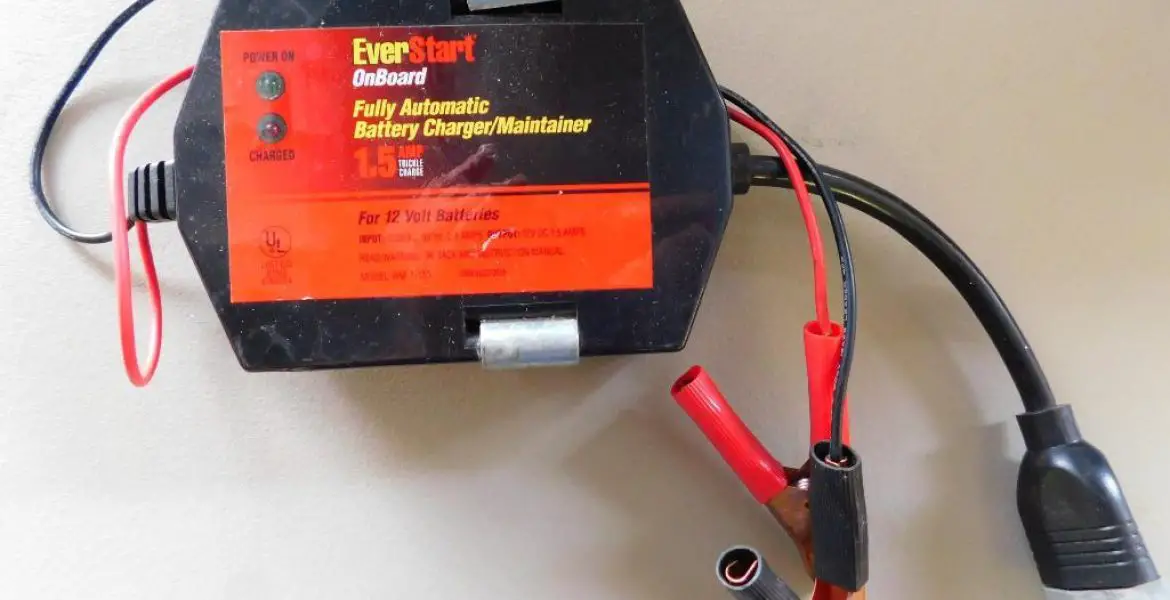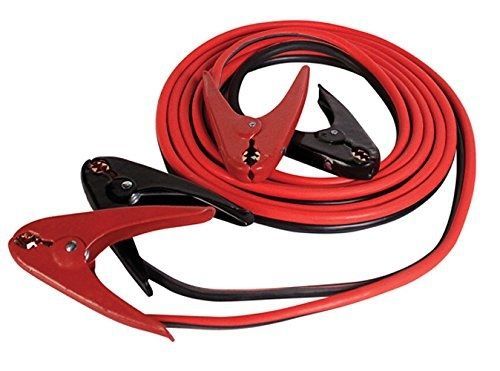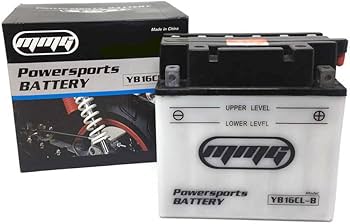
EverStart 3A Portable Smart Battery Charger and Maintainer with Digital Display
- Portable car battery charger helps power up your vehicle battery
- Compatible with 6V and 12V lead acid batteries including gelatin and Absorbent Glass Mat (AGM)
- Includes a cable with red and black clamps to easily connect
- Quick disconnect harness to use clamps or ring connectors
- Digital display shows you that your battery is charging up
- Protection against reverse polarity and short circuit
- Dual voltage 6V/12C is manually selectable
- Meets FCC and CEC testing
- UL1236 listed
- Battery charger weight: 1.06 lbs
- Battery charger dimensions: 5.5″L x 5.5″W x 7″H
$22.16
As I pulled into my garage last winter after a particularly brutal cold snap, I was greeted by the dreaded clicking sound that every vehicle owner fears. My truck’s battery had given up the ghost, and I was left stranded in my own driveway. That frustrating moment led me down a path of discovery that ultimately changed how I care for every vehicle in my household. After researching numerous solutions, I invested in an Everstart Smart Charger and Maintainer—a decision that has paid dividends in both convenience and peace of mind. In this comprehensive guide, I’ll share everything I’ve learned about this remarkable battery management system that combines cutting-edge technology with user-friendly design.
Understanding the Everstart Smart Charger and Maintainer: Specifications That Matter
The Everstart Smart Charger and Maintainer isn’t just another accessory to add to your garage collection—it’s an essential tool for anyone who owns a vehicle. Before diving into my personal experience, let’s break down what makes this device stand out from standard chargers.
The unit I purchased features multiple charging rates, typically offering 2A, 6A, and 10A settings depending on the specific model. This versatility means you can handle everything from trickle charging a motorcycle battery to quickly bringing a dead car battery back to life. The compact dimensions (approximately 8″ x 4″ x 2.5″) make it easy to store, while still feeling substantial and well-built in your hands.
What immediately caught my attention was the intuitive LCD display that clearly shows charging status, battery voltage, and any error codes. The unit weighs around 2-3 pounds, making it portable enough to move between vehicles but substantial enough to feel like a quality piece of equipment. Most models come with both battery clamps and ring terminal connections, giving you flexible options for different applications.
Operating between 100-120V AC input, the charger converts this to the DC output needed for battery charging. The cable length is generous at about 6 feet for both the AC power cord and the DC output cables, which I’ve found to be adequate for most garage setups.
How the Smart Technology Actually Works
What separates the Everstart Smart Charger from basic models is the intelligent microprocessor that continually monitors battery conditions and adjusts the charging process accordingly. This isn’t just marketing jargon—I’ve witnessed firsthand how it works through multiple charging phases.
The initial diagnostic phase evaluates your battery’s condition and determines if it can accept a charge. During my first use, I was impressed when the charger detected a slight sulfation issue in my truck battery that I hadn’t been aware of. The bulk charging phase delivers the maximum safe current to quickly bring your battery up to about 80% capacity. Then the absorption phase kicks in, gradually reducing current while maintaining voltage to safely reach full capacity.
Perhaps most valuable is the float/maintenance mode that monitors battery voltage and provides small amounts of current as needed to keep the battery at optimal charge without overcharging. This feature has been a game-changer for my seasonal vehicles that sit unused for months at a time.
The Real Cost of Ownership: Is It Worth the Investment?
When considering any purchase, I’m always focused on value rather than just the initial price tag. The Everstart Smart Charger and Maintainer typically retails between $40-$80 depending on the model and features. My 10-amp model was around $60, positioning it in the mid-range of battery chargers.
After owning it for over a year, I can confidently say the value proposition is outstanding. When you consider that a new car battery costs $100-$200, plus potential towing fees ($75-$125) if you’re stranded, the charger pays for itself the first time it saves you from a dead battery. Factor in the extended life of your batteries through proper maintenance, and the economics become even more favorable.
One aspect I didn’t initially consider was the energy efficiency. During maintenance mode, the unit draws minimal power—far less than I expected. My rough calculations suggest it costs less than $2 per month in electricity to keep a vehicle on continuous maintenance charging.
Where to Purchase: Finding the Best Deal
I purchased my Everstart Smart Charger and Maintainer at Walmart, which is the primary retailer for this brand. You’ll find them both in-store and online, often with different models available depending on location. In my experience, the physical stores sometimes have limited stock of the higher-end models, so checking online inventory before making a trip is worthwhile.
Beyond Walmart, I’ve spotted these chargers at various auto parts stores like AutoZone and O’Reilly’s, though typically at slightly higher prices. Online marketplaces like Amazon and eBay also carry them, sometimes with competitive pricing during sales events.
One shopping tip I discovered: Everstart occasionally releases updated models, which can create opportunities to find the previous generation at substantial discounts. The core technology remains similar, so these can represent excellent value.
Versatility Across Battery Types: What Can It Charge?
One of the features that sold me on the Everstart Smart Charger was its versatility across different battery types. The unit efficiently handles traditional lead-acid, AGM (Absorbent Glass Mat), gel cell, and deep-cycle batteries. This versatility means it works for practically every vehicle in my household.
I’ve successfully used it on my truck’s standard lead-acid battery, my wife’s car with an AGM battery, my son’s motorcycle, and even our lawn tractor. The charger automatically detects the battery type and adjusts its charging algorithm accordingly—a feature I’ve found to be remarkably accurate.
The only limitation I’ve encountered is with lithium-ion batteries. Some newer Everstart models claim lithium compatibility, but my model specifically warns against it in the manual. If you have specialized lithium batteries, you’ll want to verify compatibility before purchase.
Safety First: Automatic Shutoff and Protection Features
The most impressive aspect of the Everstart Smart Charger and Maintainer is its comprehensive safety feature set that protects both your batteries and your home. The automatic shutoff function prevents overcharging, which can damage batteries and potentially create dangerous situations.
In addition to overcharge protection, the unit features reverse polarity detection, which has saved me from my own mistakes more than once. The first time I connected the leads incorrectly (we’ve all done it), the charger immediately alerted me with a warning tone and display message rather than damaging the battery or the charger.
Short circuit protection, spark-proof connection technology, and overheating prevention round out the safety package. During a particularly hot summer day when I was charging in my garage, I noticed the charger temporarily reduced its output when temperatures climbed—an intelligent feature that prevents damage to the internal components.
Step-by-Step: How I Use the Charger on My Vehicles
When I first got my Everstart charger, I spent some time familiarizing myself with the proper procedure. Now it’s second nature, but for those new to battery maintenance, here’s my process:
- I always ensure the vehicle is turned off and the key is removed.
- For safety, I disconnect the negative battery terminal first if I’m removing the battery.
- After confirming the charger is unplugged, I connect the positive (red) clamp to the positive battery terminal, then the negative (black) clamp to the negative terminal.
- Only then do I plug the charger into a standard outlet.
- Using the mode button, I select the appropriate charging rate based on my needs (2A for maintenance, 6A for standard charging, 10A for fast charging).
- The display indicates charging has begun, and I let the smart technology handle the rest.
- When the display shows charging is complete, I unplug the charger first, then remove the clamps in reverse order (negative first, then positive).
For longer-term maintenance, I sometimes use the ring terminal attachments instead of the clamps, which allows for a more permanent setup on seasonal vehicles.
AGM and Deep-Cycle Performance: Beyond Basic Charging
Modern vehicles increasingly use AGM batteries, which require specific charging profiles. The Everstart Smart Charger excels here, with dedicated settings for these specialized batteries. When charging my wife’s car with its factory AGM battery, I simply select the AGM setting, and the charger adjusts its voltage and current accordingly.
For deep-cycle batteries, like the one in my fishing boat, the charger’s ability to provide a slower, more thorough charge has noticeably improved battery performance. Before using the Everstart, I found my boat battery would lose capacity after just a season or two. Now, with regular maintenance charging, I’m seeing much better longevity.
The charger’s sensitivity in detecting battery condition is particularly valuable with these specialty batteries, as they can be expensive to replace and are more susceptible to damage from improper charging.
Charging Time Expectations: How Long Will You Wait?
One of the most common questions I had before purchasing was about charging times. After extensive use with different batteries, I’ve found that charging times vary based on battery size, condition, and the selected charging rate.
For a standard car battery (approximately 50Ah) that’s moderately discharged (not completely dead), here’s what I’ve experienced:
- Using the 2A setting: 20-24 hours for a full charge
- Using the 6A setting: 7-9 hours for a full charge
- Using the 10A setting: 4-6 hours for a full charge
Completely dead batteries will take longer, as the charger initially operates at a lower current to safely recover the battery. I once resurrected a battery from my classic car that had been sitting for two years, and it took about 36 hours on the 2A setting before transitioning to normal charging rates.
The display provides a percentage indicator that I’ve found to be reasonably accurate, allowing you to gauge remaining time. One feature I particularly appreciate is that once it reaches 100%, the maintenance mode kicks in automatically, so there’s no risk in leaving it connected longer than needed.
Warranty Coverage: Protection for Your Investment
The Everstart Smart Charger and Maintainer typically comes with a one-year limited warranty, which covers manufacturing defects and component failures under normal use. While this isn’t the longest warranty in the industry, I’ve found Everstart’s customer service to be responsive when needed.
After about ten months of ownership, I noticed an intermittent issue with the display on my unit. A quick call to the customer service number in the manual connected me with a representative who guided me through a reset procedure that resolved the problem. Had that not worked, they were prepared to process a warranty replacement.
For those wanting additional protection, some retailers offer extended warranty plans for an additional fee. Personally, I didn’t opt for this, as the device seems robust enough that problems would likely appear within the standard warranty period.
Motorcycle and Small Vehicle Applications: Perfect Compatibility
Motorcycle batteries present unique charging challenges due to their smaller size and susceptibility to damage from overcharging. The Everstart’s 2A setting is ideal for these applications, providing a gentle charge that won’t overwhelm smaller batteries.
I use my charger regularly on my motorcycle during the winter months, connecting it via the ring terminals for easy access. The maintenance mode has proven perfect for this application, keeping the battery at optimal charge without the risk of damage that comes with periodic overcharging from less sophisticated chargers.
The compact size of the Everstart also makes it practical for storing near smaller vehicles. I keep mine mounted on the wall next to my motorcycle parking spot, making it a simple matter to connect the battery whenever the bike will be sitting for more than a couple of weeks.
Comprehensive Safety Features: Peace of Mind
Beyond the automatic shutoff capabilities mentioned earlier, the Everstart Smart Charger incorporates several additional safety features that provide peace of mind during operation.
The unit is designed with an IP65 rating on most models, meaning it’s dust-tight and protected against water jets—important for garage environments that might not be climate-controlled. The housing is made of flame-retardant materials, and internal temperature sensors prevent overheating.
One safety feature I particularly appreciate is the low-voltage start function. If your battery is severely depleted (below 2 volts), many chargers won’t even attempt to charge it. The Everstart can detect these deeply discharged batteries and initiate a special recovery mode that slowly brings them back to a level where normal charging can begin.
Troubleshooting Common Issues: Solutions from Experience
Despite its reliability, I’ve encountered a few situations that required troubleshooting. Here are the most common issues and their solutions:
When the charger shows “Error” or won’t initiate charging, I’ve found that checking the connections is the first step. Corrosion on battery terminals can prevent proper contact. A quick cleaning with a wire brush usually resolves this.
If the charger cycles between charging modes or seems confused about the battery state, disconnecting everything for 30 seconds to reset the internal logic often works. In stubborn cases, I’ve found that disconnecting the battery from the vehicle completely (when possible) provides the cleanest charging scenario.
For situations where the charger shows charging but the percentage never increases, I’ve learned this usually indicates a battery that’s reached the end of its useful life. In these cases, the internal resistance of the battery is too high for effective charging, and replacement is typically the only solution.
Winter Storage Solutions: Keeping Batteries Healthy Year-Round
Winter storage is where the Everstart Smart Charger truly shines. Cold temperatures are particularly hard on batteries, and vehicles that sit unused can develop deeply discharged batteries that often refuse to recover.
For my classic car that hibernates through the winter, I connect the Everstart in maintenance mode for the entire off-season. The float charge keeps the battery at optimal voltage without water loss or plate damage that can occur with continuous charging from older charger types.
The energy consumption in maintenance mode is minimal—far less than leaving a small light bulb on—so I don’t worry about electricity costs. The peace of mind knowing I won’t face a dead battery when spring arrives is well worth it.
This approach has extended the life of my seasonal vehicle batteries significantly. Before adopting this practice, I was replacing batteries every 2-3 years. My current battery is now entering its fifth year with no signs of capacity loss.
Smart vs. Regular Chargers: Why the Difference Matters
Before purchasing the Everstart, I used a conventional charger that simply applied a constant current until manually disconnected. The difference in battery performance since switching has been remarkable.
Traditional chargers apply a steady charge regardless of battery condition, which can lead to overcharging, excessive heat, water loss in the battery, and ultimately shortened lifespan. In contrast, smart chargers like the Everstart use microprocessor control to adjust the charging profile based on real-time battery feedback.
This intelligent approach means batteries receive exactly what they need at each stage of the charging process. The initial bulk charge brings capacity up quickly, while the absorption phase slows down to carefully top off the battery without damage. Finally, the float mode maintains optimal charge with minimal energy input.
For anyone still using an old-school charger, the upgrade to a smart charger is one of the most impactful improvements you can make for battery health and longevity.
Digital Display: Information at Your Fingertips
The LCD display on the Everstart Smart Charger provides valuable information that older chargers simply can’t match. At a glance, I can see:
- Current battery voltage
- Charging rate (2A, 6A, or 10A)
- Charging mode (bulk, absorption, or float)
- Percentage of charge completed
- Error codes if something needs attention
This visibility removes the guesswork from charging. Instead of wondering if your battery is receiving the right care, you can see exactly what’s happening. I particularly appreciate being able to check the voltage of a battery that’s been sitting unused—a quick connection to the charger gives me an immediate reading that helps determine if the battery needs attention before I attempt to start the vehicle.
The display is backlit, making it easy to read even in dim garage lighting. The intuitive interface requires minimal reference to the manual after initial use, with clearly labeled buttons that make operation straightforward.
Portability Considerations: Taking Charge Anywhere
The Everstart Smart Charger strikes an excellent balance between functionality and portability. At roughly 3 pounds, it’s light enough to move between vehicles or take to a friend’s house when helping with their battery issues.
The built-in cable management helps keep things organized when not in use. I keep mine hanging on a pegboard in my garage, where it’s easily accessible but doesn’t take up valuable bench space. The carrying handle integrated into some models makes transportation even more convenient.
For camping trips where I might need to maintain my RV battery, the charger’s relatively small footprint means it doesn’t consume much precious storage space. Its ability to operate from standard 120V outlets—whether in a garage or at a campsite with electrical hookups—provides flexibility for various scenarios.
Brand Comparison: How Everstart Stacks Up Against Competitors
I researched several brands before settling on the Everstart, and I’ve had opportunities to use competitors’ products through friends and family. Here’s how I think Everstart compares to other popular options:
Compared to premium brands like NOCO and Battery Tender, the Everstart offers about 80-90% of the functionality at roughly half the price. The charging algorithms are similarly effective, though the premium brands sometimes offer more detailed displays and slightly more refined user interfaces.
Against budget options, the Everstart significantly outperforms in terms of safety features, charging intelligence, and build quality. I briefly owned a generic charger that cost about $20 less than the Everstart, but its lack of proper float mode and tendency to run hot made me uncomfortable leaving it connected for maintenance charging.
The middle-ground positioning of Everstart—offering advanced features at a reasonable price point—represents the sweet spot for most users. Unless you’re a professional mechanic needing specialized features, the Everstart provides everything necessary for proper battery care.
Lithium-Ion Compatibility: The Future of Battery Technology
As mentioned earlier, lithium-ion compatibility varies by model within the Everstart line. My older unit explicitly warns against use with lithium batteries, but newer models advertise lithium compatibility as vehicles increasingly adopt this technology.
If lithium-ion charging is important for your needs, be sure to check the specific model’s capabilities before purchasing. The packaging and user manual clearly state compatible battery types. Models supporting lithium typically have dedicated lithium settings that adjust voltage and current to the specific requirements of these batteries.
For most current vehicle owners, standard lead-acid compatibility remains the priority. However, as more vehicles transition to lithium technologies, having a charger that can handle both types will become increasingly valuable.
User Reviews and Community Feedback: The Consensus
Before finalizing my purchase, I spent considerable time reading user reviews and participating in automotive forums to gauge real-world experiences. The consensus across these sources largely matched my subsequent experience:
Most users praise the Everstart’s reliability and value proposition, particularly highlighting the effective maintenance mode for seasonal vehicles. The most frequently mentioned positive aspects include the clear display, intuitive controls, and versatility across different battery types.
Critical feedback typically centers around warranty duration, with some users wishing for coverage beyond one year. Occasional mentions of display issues appear in reviews, though these seem to be relatively rare manufacturing defects rather than design flaws.
Interestingly, many reviewers mentioned purchasing the Everstart after experiencing failures with both cheaper generic chargers and more expensive premium brands, suggesting it hits a reliability sweet spot in the market.
Conclusion: Why Every Vehicle Owner Should Consider an Everstart Smart Charger
After more than a year of regular use across multiple vehicles, I’m convinced that the Everstart Smart Charger and Maintainer represents one of the best investments for any vehicle owner. The combination of intelligent charging technology, comprehensive safety features, and reasonable price point creates compelling value.
The ability to properly maintain batteries during periods of non-use has extended the life of my vehicles’ power systems, saving money and preventing inconvenient failures. The peace of mind that comes from knowing my batteries are receiving optimal care allows me to focus on enjoying my vehicles rather than worrying about whether they’ll start.
For weekend warriors, seasonal vehicle owners, or anyone who wants to maximize battery life and performance, the Everstart Smart Charger and Maintainer stands as an essential tool that delivers professional-grade results at a consumer-friendly price point. Whether you’re maintaining a daily driver, preserving a classic car through winter, or ensuring your motorcycle starts reliably after storage, this device has proven itself worthy of a permanent place in my garage—and I suspect it would in yours as well.




